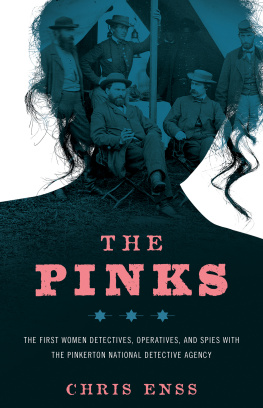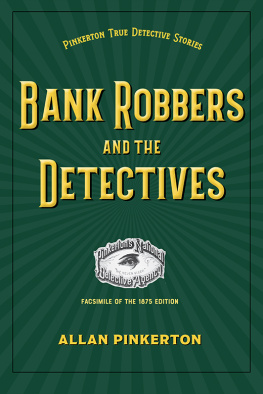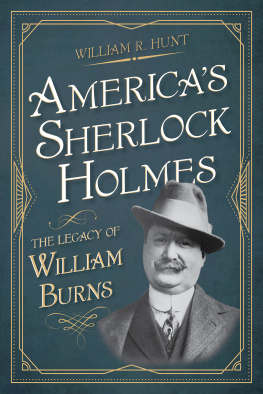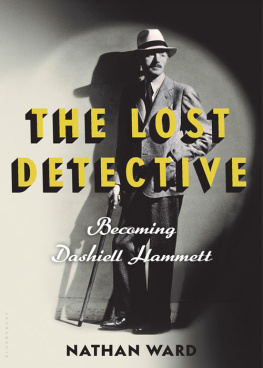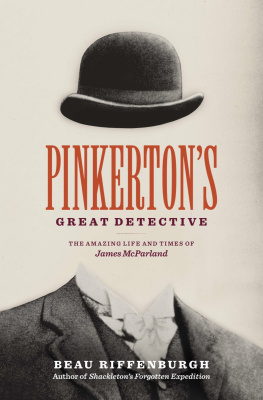INVENTING THE PINKERTONS
or, Spies, Sleuths, Mercenaries, and Thugs
INVENTING THE PINKERTONS
or, Spies, Sleuths, Mercenaries, and Thugs
BEING A STORY OF THE NATIONS MOST FAMOUS
(AND INFAMOUS) DETECTIVE AGENCY

S. Paul OHara

2016 Johns Hopkins University Press
All rights reserved. Published 2016
Printed in the United States of America on acid-free paper
9 8 7 6 5 4 3 2 1
Johns Hopkins University Press
2715 North Charles Street
Baltimore, Maryland 21218-4363
www.press.jhu.edu
Library of Congress Cataloging-in-Publication Data
Names: OHara, S. Paul, 1975 author.
Title: Inventing the Pinkertons, or, spies, sleuths, mercenaries, and thugs : being a story of the nations most famous (and infamous) detective agency / S. Paul OHara.
Description: Baltimore : Johns Hopkins University Press, 2016. | Includes bibliographical references and index.
Identifiers: LCCN 2015046698| ISBN 9781421420561 (hardcover : alk. paper) | ISBN 9781421420578 (electronic) | ISBN 1421420562 (hardcover : alk. paper) | ISBN 1421420570 (electronic)
Subjects: LCSH: Pinkertons National Detective Agency. | Pinkerton, Allan, 18191884. | Private investigatorsUnited StatesHistory. | Industrial relationsUnited StatesHistory. | LaborUnited StatesHistory.
Classification: LCC HV8087.P75 O43 2016 | DDC 363.28/90973dc23
LC record available at http://lccn.loc.gov/2015046698
A catalog record for this book is available from the British Library.
Special discounts are available for bulk purchases of this book. For more information, please contact Special Sales at 410-516-6936 or .
Johns Hopkins University Press uses environmentally friendly book materials, including recycled text paper that is composed of at least 30 percent post-consumer waste, whenever possible.
Contents
.
Acknowledgments
This project has incurred a large number of debts; my apologies to anyone I have forgotten to include. This began as part of a National Endowment for the Humanities institute entitled American Immigration Revisited. I would like to thank the institutes organizers, Alan Kraut and Maureen Murphy Nutting, as well as my fellow participants. I presented an early version of this project at the Power and the History of Capitalism conference at the New School for Social Research. Jean-Christophe Agnew, Oz Frankel, and others at the conference offered many helpful comments. My colleagues in the history department at Xavier have helped at every step of this process. Many read drafts along the way. I would especially like to thank Rachel Chrastil, Amy Whipple, David Mengel, Frank Rzeczkowski, and Julia OHara, who not only offered suggestions but also let me bounce half-baked ideas about French cultural theory, Chartism, the Special Irish Branch, Robin Hood, western outlaws and lawmen, Mexican mine strikes, and Tom Horn off them for years. Maggie Bell compiled information on the history of dime novels, Steve Towne shared some of his own research on Civil War spies, and Carey Cummings, a bona fide member of the Baker Street Irregulars, sent me all kinds of information on Sherlock Holmes and Dashiell Hammett. Liz McMahon shared her thoughts on an early version of the introduction. Robert J. Brugger at Johns Hopkins University Press believed in this project and stuck with it through several substantial revisions. I greatly appreciate his patience. The staff at Johns Hopkins University Press has been fantastic, and the anonymous readers of the manuscript offered thoughtful commentary. My thanks to all.
It is difficult to envision completing this project without a lot of additional support. My thanks to my father (who wondered, jokingly I hope, why he worked for so long in the plant only to have his son write about the Pinkertons) and my mother (who introduced me to Irish radicals and revolutionaries long ago). Julies role in this has been immeasurable; she is the first and most important sounding board for all of my ideas. None of this would be possible without her. Both Jerry and Charlie have endured many stories about bandits, outlaws, strikers, and detectives, but their enthusiasm for stories has enhanced my enthusiasm for stories. I hope that someday they will like this collection as well.
INVENTING THE PINKERTONS
or, Spies, Sleuths, Mercenaries, and Thugs
{INTRODUCTION}
Pinkertons National Detective Agency,
or heroes and villains of the Gilded Age
IN 1886, the Haymarket jury believed what agents of Pinkertons National Detective Agency had to say. The prosecution argued that a criminal conspiracy existed among the anarchists of Chicago to foment violence and revolution. Anarchists, the theory went, had designed the rally held in Haymarket Square on May 3 to lure the police into an ambush. The events of the Haymarket riot, where an unidentified assailant threw a handmade bomb into the ranks of the Chicago police, killing seven, and the police responded with gunfire into the crowd, killing at least four, were the responsibility of the anarchists. The jury saw the eight defendants own collections of explosives and dynamite, which established the means of the bombing. They heard the rhetoric of the defendants speeches and newspaper editorials, in particular anarchist threats against the Chicago Police and Pinkerton detectives, which suggested a motive for anarchists to attack authority figures. Undercover Pinkerton agent Andrew C. Johnson then provided the vital links between the public rhetoric of the anarchists, their stockpile of bombs, and their secret plans for specific acts of violence. Hired by a private association of Chicago industrialists to root out worker radicalism within the city, Johnson claimed to have infiltrated several workers militias and been privy to their plans for acts of terror.
However, when Illinois governor John Altgeld pardoned the three living Haymarket anarchists in 1893, he assumed the opposite about the testimony of Pinkerton agents. The trial was deeply flawed for several reasons, he declared, including its reliance on Pinkerton agents in the employ of industrialists.critics came to call Pinkertonism. Much of this had to do with the publics reaction to the events in Homestead, Pennsylvania, in 1892, when three hundred Pinkerton guards in the employ of Andrew Carnegie clashed violently with steel strikers. In just a few short years, with Homestead as the hinge, public opinion about labor violence and the legitimacy of the Pinkerton agency had dramatically shifted. What had seemed in 1886 to be a moral force of detectives and agents that protected society by infiltrating dangerous international criminal conspiracies had become a despised tool of capital intent on crushing dissent and worker resistance. The meaning of the agency changed because of both their actions, such as at Homestead, and broader changes in the public opinion that surrounded them. The agency, within both political discourse and the cultural imagination, had become the apotheosis of industrial violence and corporate power in Gilded Age America.
Yet the Haymarket trial and the Homestead strike were neither the first nor the last time that the American public debated the political role and cultural reputation of the Pinkerton agency. Nor would it be the only time that the Pinkerton detective served simultaneously (and paradoxically) as both a state-sponsored vanguard of law and order and an arm of plutocratic power. In an age of new market discipline and territorial expansion, Pinkertons served as a quasi-official extension of the state where the state had little other representation. As rapid industrialization triggered bloody labor conflict, the agency became, for all intents and purposes, capitals private army. It was the muscle of industry at a time when industry tried to crush dissent and consolidate its control. The Pinkerton detective, in both action and reputation, came to symbolize, for good and bad, the new industrial order.
Next page

